How to draw Banana for kids - step by step - Fact - The banana is an edible fruit, botanically a berry, produced by several kinds of large herbaceous flowering plants in the genus Musa. In some countries, bananas used for cooking may be called plantains.
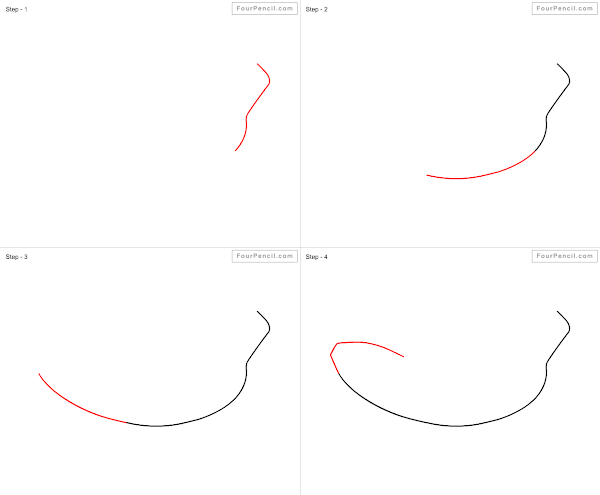
How to draw Banana for kids - step by step - Fact - The fruit is variable in size, color and firmness, but is usually elongated and curved, with soft flesh rich in starch covered with a rind which may be green, yellow, red, purple, or brown when ripe.

How to draw Banana for kids - step by step - Fact - The fruits grow in clusters hanging from the top of the plant. Almost all modern edible parthenocarpic (seedless) bananas come from two wild species – Musa acuminata and Musa balbisiana.

How to draw Banana for kids - step by step - Fact - The scientific names of most cultivated bananas are Musa acuminata, Musa balbisiana, and Musa × paradisiaca for the hybrid Musa acuminata × M. balbisiana, depending on their genomic constitution. The old scientific name Musa sapientum is no longer used.
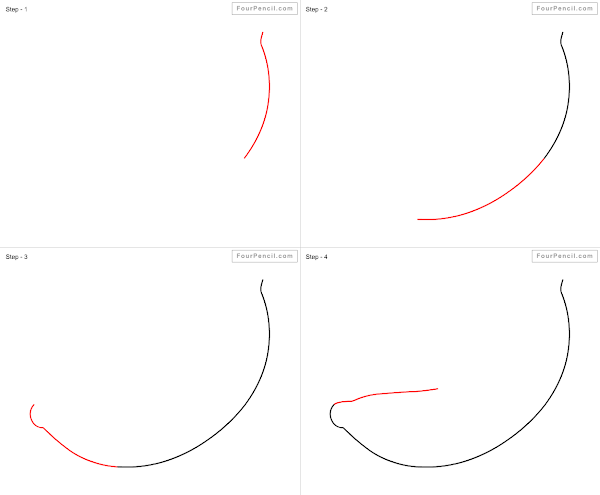
How to draw Banana for kids - step by step - Fact - Musa species are native to tropical Indomalaya and Australia, and are likely to have been first domesticated in Papua New Guinea. They are grown in at least 107 countries,[6] primarily for their fruit, and to a lesser extent to make fiber, banana wine and banana beer and as ornamental plants.

How to draw Banana for kids - step by step - Fact - Worldwide, there is no sharp distinction between "bananas" and "plantains". Especially in the Americas and Europe, "banana" usually refers to soft, sweet, dessert bananas, particularly those of the Cavendish group, which are the main exports from banana-growing countries.

How to draw Banana for kids - step by step - Fact - By contrast, Musa cultivars with firmer, starchier fruit are called "plantains". In other regions, such as Southeast Asia, many more kinds of banana are grown and eaten, so the simple two-fold distinction is not useful and is not made in local languages.
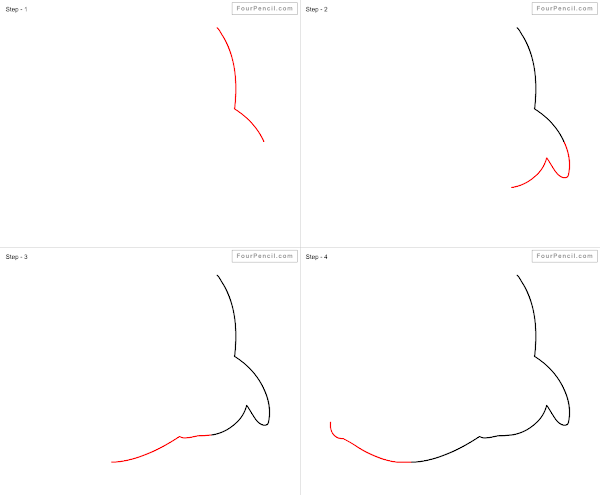
How to draw Banana for kids - step by step - Fact - The term "banana" is also used as the common name for the plants which produce the fruit. This can extend to other members of the genus Musa like the scarlet banana (Musa coccinea), pink banana (Musa velutina) and the Fe'i bananas.

How to draw Banana easy - step by step - Fact - It can also refer to members of the genus Ensete, like the snow banana (Ensete glaucum) and the economically important false banana (Ensete ventricosum). Both genera are classified under the banana family, Musaceae.

How to draw Banana easy - step by step - Fact - The banana plant is the largest herbaceous flowering plant. All the above-ground parts of a banana plant grow from a structure usually called a "corm". Plants are normally tall and fairly sturdy, and are often mistaken for trees, but what appears to be a trunk is actually a "false stem" or pseudostem.

How to draw Banana for Beginners - Fact - Bananas grow in a wide variety of soils, as long as the soil is at least 60 cm deep, has good drainage and is not compacted.[9] The leaves of banana plants are composed of a "stalk" (petiole) and a blade (lamina).
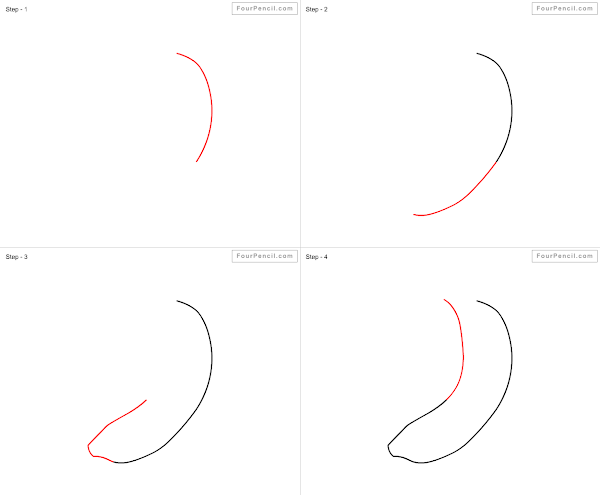
How to draw Banana for Beginners - Fact - The base of the petiole widens to form a sheath; the tightly packed sheaths make up the pseudostem, which is all that supports the plant. The edges of the sheath meet when it is first produced, making it tubular.

How to draw Banana for Children - Fact - As new growth occurs in the centre of the pseudostem the edges are forced apart. Cultivated banana plants vary in height depending on the variety and growing conditions. Most are around 5 m (16 ft) tall, with a range from 'Dwarf Cavendish' plants at around 3 m (10 ft) to 'Gros Michel' at 7 m (23 ft) or more.

 How to draw Banana for kids - step by step - Fact - The fruit is variable in size, color and firmness, but is usually elongated and curved, with soft flesh rich in starch covered with a rind which may be green, yellow, red, purple, or brown when ripe.
How to draw Banana for kids - step by step - Fact - The fruit is variable in size, color and firmness, but is usually elongated and curved, with soft flesh rich in starch covered with a rind which may be green, yellow, red, purple, or brown when ripe.  How to draw Banana for kids - step by step - Fact - The fruits grow in clusters hanging from the top of the plant. Almost all modern edible parthenocarpic (seedless) bananas come from two wild species – Musa acuminata and Musa balbisiana.
How to draw Banana for kids - step by step - Fact - The fruits grow in clusters hanging from the top of the plant. Almost all modern edible parthenocarpic (seedless) bananas come from two wild species – Musa acuminata and Musa balbisiana.  How to draw Banana for kids - step by step - Fact - The scientific names of most cultivated bananas are Musa acuminata, Musa balbisiana, and Musa × paradisiaca for the hybrid Musa acuminata × M. balbisiana, depending on their genomic constitution. The old scientific name Musa sapientum is no longer used.
How to draw Banana for kids - step by step - Fact - The scientific names of most cultivated bananas are Musa acuminata, Musa balbisiana, and Musa × paradisiaca for the hybrid Musa acuminata × M. balbisiana, depending on their genomic constitution. The old scientific name Musa sapientum is no longer used.  How to draw Banana for kids - step by step - Fact - Musa species are native to tropical Indomalaya and Australia, and are likely to have been first domesticated in Papua New Guinea. They are grown in at least 107 countries,[6] primarily for their fruit, and to a lesser extent to make fiber, banana wine and banana beer and as ornamental plants.
How to draw Banana for kids - step by step - Fact - Musa species are native to tropical Indomalaya and Australia, and are likely to have been first domesticated in Papua New Guinea. They are grown in at least 107 countries,[6] primarily for their fruit, and to a lesser extent to make fiber, banana wine and banana beer and as ornamental plants.  How to draw Banana for kids - step by step - Fact - Worldwide, there is no sharp distinction between "bananas" and "plantains". Especially in the Americas and Europe, "banana" usually refers to soft, sweet, dessert bananas, particularly those of the Cavendish group, which are the main exports from banana-growing countries.
How to draw Banana for kids - step by step - Fact - Worldwide, there is no sharp distinction between "bananas" and "plantains". Especially in the Americas and Europe, "banana" usually refers to soft, sweet, dessert bananas, particularly those of the Cavendish group, which are the main exports from banana-growing countries.  How to draw Banana for kids - step by step - Fact - By contrast, Musa cultivars with firmer, starchier fruit are called "plantains". In other regions, such as Southeast Asia, many more kinds of banana are grown and eaten, so the simple two-fold distinction is not useful and is not made in local languages.
How to draw Banana for kids - step by step - Fact - By contrast, Musa cultivars with firmer, starchier fruit are called "plantains". In other regions, such as Southeast Asia, many more kinds of banana are grown and eaten, so the simple two-fold distinction is not useful and is not made in local languages.  How to draw Banana for kids - step by step - Fact - The term "banana" is also used as the common name for the plants which produce the fruit. This can extend to other members of the genus Musa like the scarlet banana (Musa coccinea), pink banana (Musa velutina) and the Fe'i bananas.
How to draw Banana for kids - step by step - Fact - The term "banana" is also used as the common name for the plants which produce the fruit. This can extend to other members of the genus Musa like the scarlet banana (Musa coccinea), pink banana (Musa velutina) and the Fe'i bananas.  How to draw Banana easy - step by step - Fact - It can also refer to members of the genus Ensete, like the snow banana (Ensete glaucum) and the economically important false banana (Ensete ventricosum). Both genera are classified under the banana family, Musaceae.
How to draw Banana easy - step by step - Fact - It can also refer to members of the genus Ensete, like the snow banana (Ensete glaucum) and the economically important false banana (Ensete ventricosum). Both genera are classified under the banana family, Musaceae.  How to draw Banana easy - step by step - Fact - The banana plant is the largest herbaceous flowering plant. All the above-ground parts of a banana plant grow from a structure usually called a "corm". Plants are normally tall and fairly sturdy, and are often mistaken for trees, but what appears to be a trunk is actually a "false stem" or pseudostem.
How to draw Banana easy - step by step - Fact - The banana plant is the largest herbaceous flowering plant. All the above-ground parts of a banana plant grow from a structure usually called a "corm". Plants are normally tall and fairly sturdy, and are often mistaken for trees, but what appears to be a trunk is actually a "false stem" or pseudostem.  How to draw Banana for Beginners - Fact - Bananas grow in a wide variety of soils, as long as the soil is at least 60 cm deep, has good drainage and is not compacted.[9] The leaves of banana plants are composed of a "stalk" (petiole) and a blade (lamina).
How to draw Banana for Beginners - Fact - Bananas grow in a wide variety of soils, as long as the soil is at least 60 cm deep, has good drainage and is not compacted.[9] The leaves of banana plants are composed of a "stalk" (petiole) and a blade (lamina).  How to draw Banana for Beginners - Fact - The base of the petiole widens to form a sheath; the tightly packed sheaths make up the pseudostem, which is all that supports the plant. The edges of the sheath meet when it is first produced, making it tubular.
How to draw Banana for Beginners - Fact - The base of the petiole widens to form a sheath; the tightly packed sheaths make up the pseudostem, which is all that supports the plant. The edges of the sheath meet when it is first produced, making it tubular.  How to draw Banana for Children - Fact - As new growth occurs in the centre of the pseudostem the edges are forced apart. Cultivated banana plants vary in height depending on the variety and growing conditions. Most are around 5 m (16 ft) tall, with a range from 'Dwarf Cavendish' plants at around 3 m (10 ft) to 'Gros Michel' at 7 m (23 ft) or more.
How to draw Banana for Children - Fact - As new growth occurs in the centre of the pseudostem the edges are forced apart. Cultivated banana plants vary in height depending on the variety and growing conditions. Most are around 5 m (16 ft) tall, with a range from 'Dwarf Cavendish' plants at around 3 m (10 ft) to 'Gros Michel' at 7 m (23 ft) or more. 

















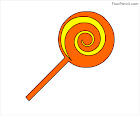
No comments:
Post a Comment